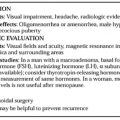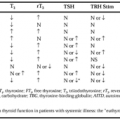ADVERSE EFFECTS OF IODIDE
Part of “CHAPTER 37 – ADVERSE EFFECTS OF IODIDE“
EXTRATHYROIDAL EFFECTS
The adverse effects of iodides may be classified as extrathyroidal or intrathyroidal. Extrathyroidal effects are uncommon; the most frequently encountered is sialoadenitis, which occurs after the administration of large doses of iodide. (Therapeutic doses of radioactive iodine also may cause sialoadenitis; however, this depends on the radiation dose rather than on the extremely small amount of stable iodine administered.) The acute, painful swelling of the parotid and other salivary glands resolves shortly after iodide therapy is discontinued. Severe skin eruptions have been reported after topical and enteral iodine exposure. In addition, “iodism” may occur, which is marked by symptoms of metallic taste, acneiform skin lesions, mucous membrane irritation, nausea, and salivary gland swelling. These symptoms subside on withdrawal of iodide. Various allergic reactions, including a syndrome similar to polyarteritis nodosa, eosinophilia, and fever, also have been reported. Drug sensitivity rashes, including dermatitis herpetiformis and hypocomplementemic vasculitis, can occur after iodide exposure but are rare.7
Stay updated, free articles. Join our Telegram channel

Full access? Get Clinical Tree





